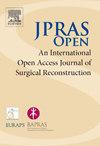游离皮瓣广泛头皮软组织重建:一种基于回顾性分析的供体部位选择的简化治疗算法。
IF 1.5
Q3 SURGERY
引用次数: 0
摘要
由于患者的复杂需求往往超出了常规治疗的范围,因此广泛的头皮缺损提出了一个重大的重建挑战,这使得游离皮瓣成为最可靠的解决方案。尽管这种情况下有各种各样的自由皮瓣,但选择最合适的选择缺乏明确的标准。本研究的主要目的是为自由皮瓣供体位置的选择提供一个简化的指导,以达到最佳的重建效果。材料与方法:回顾性研究了2017年至2022年期间15例使用游离皮瓣进行头皮重建的患者:4个背阔肌(LD), 4个网膜(OM), 5个大腿前外侧(ALT)和2个前臂桡骨游离(RFF)皮瓣。收集、评估和比较所有患者的重建和术后数据。结果:修复的平均缺损面积为110.60±14.55 cm²(LD为162.23±23.1 cm2, OM为141.68±11.80 cm2, ALT为73.83±14.69 cm2, RFF为37.13±4.88 cm2)。报告了7例并发症,以部分皮瓣丢失最为常见:LD n = 2, OM = 3。供、受体部位平均愈合时间分别为2.53±0.27个月和1.8±0.31个月,其中OM的平均愈合时间最长(3.65±0.24个月)。结论:在选择皮瓣时,重建大面积头皮缺损需要仔细考虑缺损大小、供体组织的可用性、辅助治疗的需要和患者合并症等关键因素。这强调了量身定制的方法对提高临床结果的重要性。我们提出了一种简化的自由皮瓣选择算法,以简化复杂情况下的决策过程。本文章由计算机程序翻译,如有差异,请以英文原文为准。
Extensive scalp soft-tissue reconstruction with free flaps: A simplified therapeutic algorithm for donor site selection based on a retrospective analysis
Introduction
Extensive scalp defects present a significant reconstructive challenge due to the complex needs of patients that are often beyond the scope of conventional therapies, which makes free flaps the most reliable solution. Despite the variety of free flaps available for such cases, there is a lack of clear criteria for selecting the most suitable option. The primary objective of this study was to provide a simplified guide for the selection of donor sites for free flaps for achieving optimal reconstruction outcomes.
Materials and Methods
A retrospective study was conducted on 15 patients who underwent scalp reconstruction with free flaps between 2017 and 2022: 4 latissimus dorsi (LD), 4 omental (OM), 5 anterolateral thigh (ALT), and 2 radial forearm free (RFF) flaps. Reconstructive and postoperative data for all patients were collected, evaluated, and compared.
Results
The mean defect size to be restored was 110.60 ± 14.55 cm² (LD 162.23 ± 23.1 cm2, OM 141.68 ± 11.80 cm2, ALT 73.83 ± 14.69 cm2, and RFF 37.13 ± 4.88 cm2). Seven complications were reported, with partial flap loss being the most common: LD n = 2 and OM = 3. Mean healing time of the donor and recipient sites was 2.53 ± 0.27 and 1.8 ± 0.31 months, respectively, with OM having the longest average period for recipient site healing (3.65 ± 0.24 months).
Conclusion
Reconstructing extensive scalp defects requires careful consideration of critical factors such as defect size, donor tissue availability, need for adjuvant therapies, and patient comorbidities when selecting a flap. This underscores the importance of tailored approaches to enhance clinical outcomes. We propose a simplified algorithm for free flap selection to streamline the decision-making process in complex cases.
求助全文
通过发布文献求助,成功后即可免费获取论文全文。
去求助
来源期刊

JPRAS Open
Medicine-Surgery
CiteScore
1.60
自引率
0.00%
发文量
89
审稿时长
22 weeks
期刊介绍:
JPRAS Open is an international, open access journal dedicated to publishing case reports, short communications, and full-length articles. JPRAS Open will provide the most current source of information and references in plastic, reconstructive & aesthetic surgery. The Journal is based on the continued need to improve surgical care by providing highlights in general reconstructive surgery; cleft lip, palate and craniofacial surgery; head and neck surgery; skin cancer; breast surgery; hand surgery; lower limb trauma; burns; and aesthetic surgery. The Journal will provide authors with fast publication times.
 求助内容:
求助内容: 应助结果提醒方式:
应助结果提醒方式:


